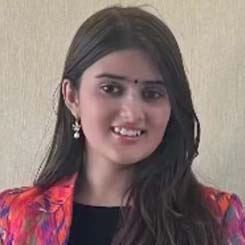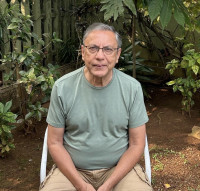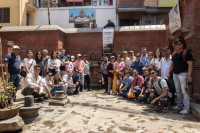Culture & Lifestyle
How Nepali musicians are redefining stardom in the digital age
With TikTok trends, YouTube streams, and Instagram reels reshaping how music is made and consumed, a new generation of Nepali singers reflects on the promises and pressures of digital stardom.
Reeva Khanal
In today’s age, social media plays a central role in our content consumption. With their short-form reels and videos, platforms such as TikTok and Instagram have shortened attention spans, captivating audiences in mere seconds. This digital shift has also opened doors for creativity, allowing anyone with an account to showcase their talents to a broad audience. During the lockdown, for instance, many posted videos of cooking, art, and music, gaining recognition directly from their online presence. This has been particularly evident in Nepali music: while established singers with a legacy continue to enjoy a dedicated following, a new generation of artists rising from YouTube and other social media platforms has amassed millions of fans and even engaged in international collaborations.
According to a report by OnlineKhabar published in April 2024, over 6,500 Nepali songs were released on YouTube in a single year, yet only a handful managed to capture lasting public attention. While digital platforms have made it easier than ever for independent artists to reach listeners, they have also intensified competition, making the journey from online upload to nationwide recognition increasingly challenging.
Sujal Sharma, a singer and songwriter, passionate about music since childhood, has spent the last eight to ten years sharing his work through YouTube and other digital platforms. For him, the rise of social media has changed how music reaches listeners and transformed the dreams artists pursue today. “Earlier, playback singing was the ultimate epitome. Singers would aspire to lend their voice to actors and actresses on the big screen. But now the trend has shifted—success is measured in terms of Spotify followers, YouTube streams, or digital reach,” Sharma explains. He sees this shift as a positive change, giving every artist the power to dream, create, and showcase their work independently, rather than waiting for opportunities to arrive through films or labels.
Looking ahead, Sharma believes that every platform has its own unique role in shaping an artist’s journey. “YouTube is where you put your full-length music videos. TikTok is for those 15 to 20-second clips that can go viral, while Instagram is more about personal branding—showing behind-the-scenes, teasers, and upcoming projects,” he says. Yet, with this accessibility comes an oversaturated market, where thousands of artists constantly release music. Sustaining visibility, he believes, depends heavily on understanding algorithms and maintaining consistency. “If you stop posting for a while, the algorithm pushes something else. To stay visible, you need to keep creating. But not everyone can access good cameras, gadgets, or professional setups, making the journey more challenging—even if the platforms are open to everyone.”
Sharma points out that fame is often fleeting in today’s era, where everything is exposed, amplified, and constantly chasing virality. A reality show win or a viral clip may give an artist temporary stardom, but it rarely lasts. He stresses that artists must focus on producing meaningful and consistent work rather than clinging to momentary viral success. Only then can they sustain their presence in the industry and ensure that audiences remember them beyond a passing trend.
While Sharma highlights consistency as the key to longevity, Nigam Acharya, a singer, songwriter, and composer, underlines how social media has fundamentally disrupted the old stardom system. “Before, you needed TV, radio, or big labels to get noticed. Now, anyone can share their music and reach thousands of people directly,” he says. Yet, he also points to new pressures: “With social media, you need to keep posting, fight with algorithms, and adapt to audiences who lose interest quickly. Songs are often consumed as a vibe rather than an art, making it harder to create lasting impact.”
For Acharya, managing everything alone has been rewarding yet demanding. “I’ve learned to think not just like a singer but also like a brand,” he explains. “It makes me more aware of what listeners want, but sometimes the focus on promotion takes away from pure creativity—and that’s the bad side of it.” Still, he embraces the freedom digital platforms provide: “Earlier, you had to sing for films or big shows to get fame. Now independent artists can build their own identity and reach fans directly. It gives us more freedom.”
Reflecting on milestones in his career, Acharya recalls how small victories first motivated him. “The first time one of my songs got good views on YouTube felt like a turning point—even a thousand views seemed big. Later, when a clip of my song went trending on TikTok, it gave me confidence that people were actually enjoying my music.” But for him, true success goes beyond numbers. “For me, success is not just going viral. It’s when people connect with my song, sing it in shows, or remember it even after years. Virality is nice, but real success has long-term impact.”
Following Acharya’s insights on virality and long-term impact, Achal Shahi Thakuri offers a glimpse into how emerging artists are navigating the new digital landscape. Since beginning his journey in 2018 with short, engaging videos on TikTok and Instagram Reels, Thakuri has grown steadily, recently releasing his full-length music video, ‘Saptarangi’, marking a major milestone in his career. Reflecting on the role of social media in his rise, he notes, “Social media has definitely changed the game. Earlier, you’d need to ‘know someone’ in the industry to even get noticed, but now platforms like YouTube, TikTok, and Instagram let us put our work out there directly. I won’t say gatekeeping is completely gone—some doors still open easier for industry insiders—but now we can create our own doors.”
Thakuri also emphasises the dual challenge of being both artist and strategist: “It’s a lot—from writing and singing to thinking about how to promote it, what visuals to use, and when to post. I’ve been making funny videos for six or seven years, so I know how to grab attention online—that helps with branding and creative storytelling. But, handling everything yourself also forces you to think differently. Creativity isn’t just about the song now—it’s about how you present it. It’s challenging but satisfying because everything people see is 100 percent me.”
He reflects on a key turning point in his journey: “My funny content initially gave me visibility, but when I started posting singing videos, especially covers, people began to see that I had more to offer—not just comedy. That shift, where audiences started appreciating my singing too, was significant. Now, with my original music coming out, it feels like all those steps led to this.”
Building on Thakuri’s observations, Aashish Chapagai, singer, songwriter, and leader of the band Jhyai Kuti, reflects on the evolving Nepali music scene. He notes that social media has made it easier for artists to reach listeners compared to previous generations.
At the same time, he acknowledges the demands of being an independent artist: “Somehow it feels hectic and tiring to do everything yourself, but on the other hand, you learn so many things,” he notes. Taking on the responsibilities of managing songs, promotion, and branding has shaped his approach to creativity, encouraging him to experiment and grow as an artist.
Chapagai began his musical journey at 14/15, releasing his first original songs at 19. To date, he has released ten originals, with one track called ‘Jhyai Kuti jhyai’ amassing almost 200,000 views on YouTube. “The Voice of Nepal was the best place to share my work with people,” he says, referring to his selection on Season 6 in 2025, which offered further exposure.
On defining success, Chapagai focuses on long-term impact rather than fleeting virality. “For me, long-term impact matters most,” he notes, underscoring his desire to create music that resonates with audiences well beyond the initial release.
Srijana Regmi—a singer, songwriter, and model—represents a more critical voice in this digital transformation. “Artists no longer need to abide by formulas of how their music should or should not be. I prefer this new freedom that musicians have,” she says. “Nevertheless, artists now care more about the virality of their music among a very distracted, short attention-spanned audience and design their music to cater to it rather than challenging the narrative.”
While she runs her own social media, she collaborates with producers AJ Bhandary and Mike Serman under KTM Collective for music video production and promotion. “I find it beautiful that I don’t have to censor myself and can speak my mind through social media and music itself,” she explains.
Her debut song ‘Murder Mountain’ became pivotal, as its dark undertones resonated with a niche but dedicated audience. “It proved to me that Nepali listeners are not just accepting but appreciative of the dark undertones in my songs. It reflects the feelings of a niche audience, and I feel grateful to be able to reflect it through my music,” Regmi reflects.
Looking forward, she remains cautious about the industry’s trajectory. “Nepali musicians will have a window to reach potential listeners worldwide through these platforms. However, I worry that artists’ true expression will be diluted by the need for survival in this fast-paced, capitalistic economy,” she says.
Prajina Gurung, a singer and independent artist, describes social media as both a liberating and demanding force in today’s music industry. “It’s no longer just about industry connections—any artist with talent and consistency can share their work and find an audience,” she says. For her, platforms like YouTube, TikTok, and Instagram have democratised music, allowing newcomers to grow based on creativity rather than connections.
Gurung also points to the broader shift in stardom brought about by social media. “It’s not that playback singers don’t get recognition—they do. But today, with the popularity of short-form videos and constant content, independent artists can gain attention more quickly and from a wider, more diverse audience,” she explains. For her, this change is a welcome one: it allows artists to connect directly with listeners, build their own communities, and sustain careers through authenticity and consistency.
Looking ahead, she sees digital platforms only becoming more central. “YouTube, TikTok, and Instagram will continue to democratise music in Nepal, giving fresh voices the chance to reach wider audiences, challenge conventional industry norms, and shape the future of Nepali music in ways that were not possible before.”
These experiences highlight a clear shift in Nepal’s musical landscape. Social media and digital platforms have broken traditional barriers, giving independent artists the tools to reach audiences directly, build personal brands, and create opportunities. While the path comes with new pressures—constant content creation, navigating algorithms, and maintaining listener interest—the rewards are equally transformative.




 5.14°C Kathmandu
5.14°C Kathmandu















